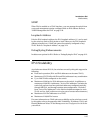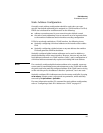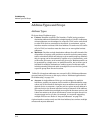
3-5
IPv6 Addressing
IPv6 Addressing Options
IPv6 Addressing Options
IPv6 Address Sources
IPv6 addressing sources provide a flexible methodology for assigning
addresses to VLAN interfaces on the switch. Options include:
■ stateless IPv6 autoconfiguration on VLAN interfaces includes:
• link-local unicast addresses
• global unicast addresses
■ stateful, global unicast IPv6 address configuration using DHCPv6
■ static IPv6 address configuration
You can combine stateless, stateful, and static IP addressing methods on the
switch as needed, according to the needs in your network. For example, if
your network includes only one VLAN, you may need only stateless autocon-
figuration of link-local addresses, although you could also use the static IPv6
method. (DHCPv6 does not configure link-local addresses.) Where routed
traffic is used, you will also need global unicast addressing, either through
stateless autoconfiguration or the other listed methods.
General IPv6 Address Types
IPv6 supports stateless and stateful address autoconfiguration, as well as
static address configuration.This enables IPv6 to automatically address a
device so that it can be placed in a network with or without static or DHCPv6
addressing intervention. All three of these methods can be used exclusively
or in conjunction with each other, and a given IPv6 device can have multiple
addresses assigned to the same interface in a manner similar to subnetting in
IPv4.
Stateless Address Autoconfiguration . This method does not require the
use of servers. Instead, in the default operation, the host uses its MAC address
to automatically generate a link-local IPv6 address using the EUI-64 method
to generate the device identifier. (Refer to “Autoconfiguring Link-Local
Unicast Addresses” on page 3-13.) The scope of the link-local address enables
communication with other IPv6 devices on the same VLAN. If an IPv6 router
is present, an IPv6 address supporting routing is automatically generated, as
well. (The switch merges a router-generated prefix received in router adver-
tisements with the last 64 bits of thelink-local address on an interface to create
the global address.) Refer to page 3-7.


















